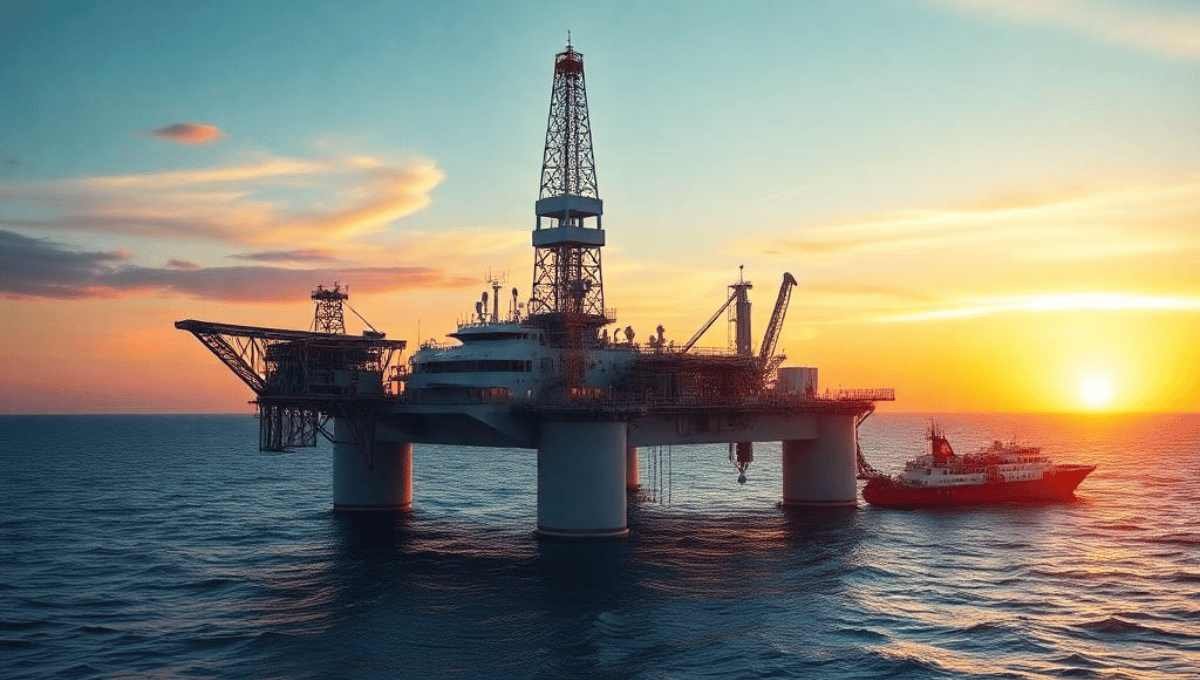Deep Offshore Technology is the key to unlocking the vast depths of the ocean that hold immense potential. From harnessing renewable energy to accessing vital oil and gas reserves, this technology enables us to work where few have ventured before. With advanced systems designed for extreme underwater environments, industries can safely and efficiently explore these untapped frontiers. As innovations in automation, robotics, and sustainable practices continue to evolve, deep offshore technology is shaping the future of energy and environmental stewardship. This blog explores its history, challenges, applications, and groundbreaking advancements transforming ocean exploration today.
Table of Contents
What Is Deep Offshore Technology?
Deep offshore technology encompasses specialized systems, tools, and techniques enabling industries to operate efficiently in underwater environments. These technologies allow the extraction of resources, production of energy, and exploration at extreme ocean depths, often several miles beneath the surface. They are vital for accessing untapped resources while ensuring operations are safe and sustainable in harsh conditions.
A Historical Perspective: From Early Attempts to Advanced Innovations
Early Efforts
The foundation of deep offshore technology lies in the initial attempts at oil drilling and marine exploration. Early efforts relied on rudimentary tools and methods that paved the way for more sophisticated approaches. These basic techniques laid the groundwork for the technological progress that followed.
20th Century Progress
The 1900s marked a turning point with the introduction of semi-submersible platforms and dynamic positioning systems. These innovations improved stability and precision during operations, enabling safer and more efficient underwater exploration. They transformed the scope of offshore activities and set the stage for advanced engineering.
Modern Automation
Today, AI, robotics, and real-time data monitoring have revolutionized offshore operations. These advancements improve decision-making, minimize human risk, and enhance efficiency. With automation at the core, modern deep offshore technology is more effective and adaptive to challenging underwater environments.
Core Components of Deep Offshore Technology
Subsea Engineering
Subsea engineering involves designing robust equipment to handle extreme underwater conditions. Components are built to withstand immense pressure, corrosive saltwater, and freezing temperatures, ensuring long-term durability. This engineering is critical for successful operations at great depths.
Production Systems
Subsea production systems and FPSOs play a pivotal role in extracting and processing resources offshore. These floating platforms are designed to store and offload resources efficiently while ensuring operational safety and sustainability in demanding conditions.
Autonomous Vehicles
AUVs are essential for mapping, inspection, and maintenance tasks in deepwater environments. These unmanned vehicles operate without human intervention, improving precision, reducing risks, and enabling exploration in areas previously considered inaccessible.
Innovations Driving the Industry
- AI and Machine Learning: AI and machine learning optimize drilling processes, forecast maintenance needs, and monitor operations in real-time. These technologies streamline workflows, enhance efficiency, and ensure safety by providing predictive insights.
- Diving Systems: Advanced diving systems ensure human divers can safely conduct repairs and inspections at significant depths. These systems include specialized equipment and procedures that protect divers from the dangers of deepwater environments.
- Environmental Monitoring: Modern technologies actively monitor marine ecosystems, ensuring operations have minimal environmental impact. This includes tracking biodiversity, detecting potential disruptions, and mitigating harm to underwater habitats.
Applications of Deep Offshore Technology
Oil and Gas Exploration
Deep offshore technology unlocks access to previously unreachable reserves, supporting global energy demands. Enabling resource extraction at great depths ensures the continued availability of oil and gas.
Renewable Energy
Offshore wind farms and marine energy projects contribute to clean, sustainable energy generation. These technologies reduce reliance on fossil fuels, playing a crucial role in combating climate change.
Economic Growth
Deep offshore operations create jobs, drive technological innovation, and boost economies. By tapping into ocean resources, industries contribute to global development and energy independence.
Challenges in Deep Offshore Operations
- Operating Conditions: Deepwater environments involve extreme pressure, low temperatures, and unpredictable weather. These challenges require specialized equipment and strategies to maintain operational safety and efficiency.
- Material Fatigue: Exposure to salt water and constant mechanical stress causes wear and tear on equipment. Addressing material fatigue is critical for ensuring long-term performance and preventing failures.
- High Costs: Offshore projects are capital-intensive, requiring substantial investments in equipment, infrastructure, and safety measures. Balancing costs while maintaining operational efficiency is a significant challenge.
Environmental Impacts and Sustainability
- Marine Protection: Deep offshore technologies incorporate methods to minimize harm to marine ecosystems. Strategies include careful planning, impact assessments, and the use of eco-friendly equipment.
- Oil Spill Mitigation: Advanced detection and response systems reduce the risk of spills and limit their impact when they occur. These systems enhance readiness and minimize environmental damage.
- Sustainable Practices: Adopting green initiatives, such as using renewable energy and reducing emissions, ensures offshore operations are more sustainable and environmentally responsible.
Economic and Regulatory Factors
- Investment Costs: Offshore ventures require significant capital for research, development, and infrastructure. Managing these investments effectively is essential for long-term success.
- Safety Standards: Strict regulations ensure worker safety and environmental protection. Adhering to these standards helps maintain operational integrity and reduces risks.
Future Trends in Deep Offshore Technology
AI Integration
AI advancements promise improved decision-making, operational efficiency, and reduced risks. These systems enable smarter and more adaptive offshore operations.
Smarter Pipelines
Sensors and IoT-enabled pipelines enhance resource transport, providing real-time monitoring and reducing downtime. These innovations improve efficiency and safety.
Materials Research
Developing new composites and alloys improves resistance to pressure, corrosion, and fatigue, ensuring durability in extreme environments.
Global Collaboration and Growth Opportunities
- Partnerships: International collaborations bring expertise, resources, and innovation together. Joint efforts accelerate technological progress and expand operational capabilities.
- Emerging Markets: New regions, particularly in Asia and Africa, are investing heavily in offshore technology. These markets offer significant opportunities for economic and industrial growth.
Success Stories: Pioneering Projects in Deep Offshore Technology
Projects like Brazil’s pre-salt basin highlight engineering excellence, producing resources efficiently and sustainably. Offshore wind farms in Europe have scaled renewable energy production, powering millions of homes. Subsea robotics advancements continue to improve safety and operational efficiency.
Benefits of Advancing Deep Offshore Technology
- Resource Access: Unlocking hidden reserves ensures a steady supply of essential resources, supporting global energy demands.
- Improved Safety: Advanced systems reduce risks to workers and equipment, enhancing safety across offshore operations.
- Eco-Friendly Energy: Investments in renewables, like wind and marine energy, align offshore technology with sustainable goals.
Solutions to Key Challenges
- Innovative Engineering: Developing equipment capable of withstanding extreme conditions ensures reliable and safe operations.
- Cost Reductions: Collaborative research, improved designs, and economies of scale help reduce operational expenses.
- Eco-Friendly Designs: Incorporating sustainable materials and energy sources minimizes environmental impact while improving efficiency.
Conclusion
Deep offshore technology is revolutionizing the way we explore and utilize ocean resources. By integrating advanced components like subsea systems, autonomous vehicles, and AI, industries have made significant strides in efficiency and safety. These technologies unlock access to untapped resources, power renewable energy projects, and support economic growth globally.
However, challenges persist. Harsh environmental conditions, high costs, and sustainability concerns require innovative solutions and global collaboration. By investing in smarter materials, eco-friendly practices, and regulatory compliance, industries can address these obstacles effectively.
As we look to the future, the combination of cutting-edge tools and a commitment to sustainability ensures that deep offshore technology remains at the forefront of oceanic advancements, driving progress while safeguarding the planet’s ecosystems.
FAQ’s
What is Deep Offshore Technology?
Deep offshore technology involves tools, systems, and methods used for resource extraction, energy production, and exploration in deep ocean environments. It supports industries in accessing untapped resources under extreme underwater conditions.
How has the technology used for deep-offshore fishing changed over the recent past?
Deep offshore fishing technology has advanced with modern sonar systems, GPS navigation, and sustainable fishing practices. These innovations ensure efficient catches while minimizing ecological impact.
What are the components that make up deep offshore technology to explore?
Key components of deep offshore technology include subsea engineering, autonomous underwater vehicles (AUVs), and floating production systems like FPSOs. These enable operations in challenging underwater environments.
What is marine and offshore technology?
Marine and offshore technology focuses on systems and tools designed for operations in marine environments, including resource extraction, energy production, and underwater exploration.
How much do offshore Marines get paid?
Offshore Marines typically earn $50,000 to $100,000 annually, depending on experience, role, and location of deployment.
How to become an offshore engineer?
To become an offshore engineer, obtain a degree in engineering (mechanical, civil, or marine), gain experience in marine operations, and pursue specialized certifications in offshore technology.
Do you know of any environmental effects from drilling deep offshore?
Deep offshore drilling can affect marine ecosystems, including risks of oil spills and habitat disruption. Advances in deep offshore technology help mitigate these impacts.
What developments can we anticipate from this field shortly?
Future developments in deep offshore technology include AI-powered systems, smarter pipelines with IoT integration, and eco-friendly materials for sustainable underwater operations.
Trending Article: What Is Waterproofing in Circus Hartfield Articles? A Complete Guide

